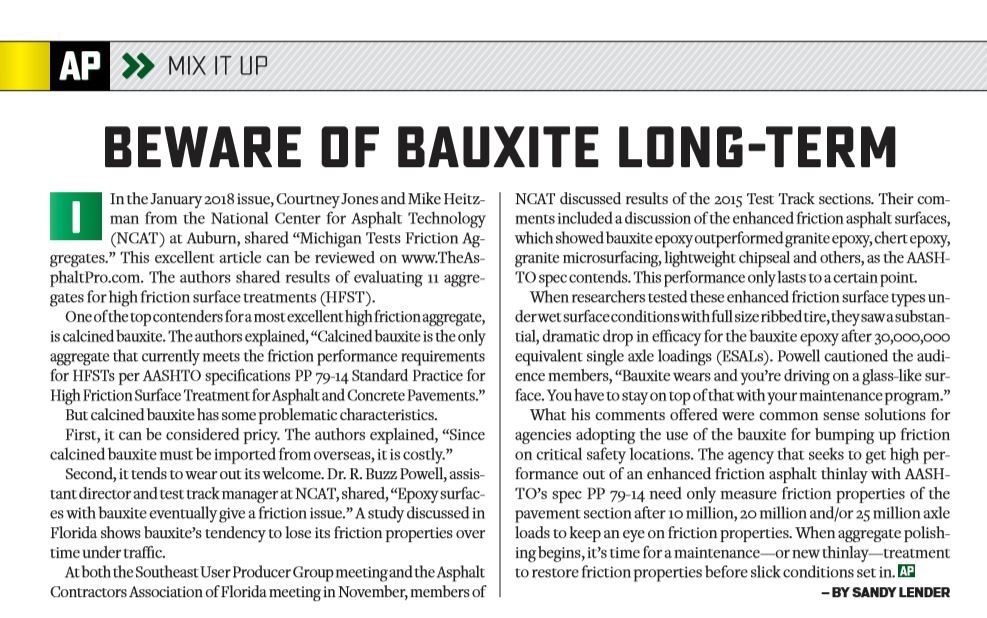Beware of Bauxite Long-term
BY Sandy Lender

In the January 2018 issue, Courtney Jones and Mike Heitzman from the National Center for Asphalt Technology (NCAT) at Auburn, shared “Michigan Tests Friction Aggregates” from their contribution to the fall 2017 NCAT Newsletter. This excellent article can be reviewed on www.TheAsphaltPro.com. The authors shared results of evaluating 11 aggregates for high friction surface treatments (HFST).
One of the top contenders for High Friction Aggregate of the Planet, if such an award were in existence, is calcined bauxite. The authors explained, “Calcined bauxite is the only aggregate that currently meets the friction performance requirements for HFSTs per AASHTO specifications PP 79-14 Standard Practice for High Friction Surface Treatment for Asphalt and Concrete Pavements.”
But calcined bauxite has some problematic characteristics.
First, it can be considered pricy. The authors explained, “Since calcined bauxite must be imported from overseas, it is costly.”
Second, it tends to wear out its welcome. Dr. R. Buzz Powell, assistant director and test track manager at NCAT, shared, “Epoxy surfaces with bauxite eventually give a friction issue.” Let’s look at a study discussed in Florida for support of bauxite’s tendency to lose its friction properties over time under traffic.
At both the Southeast User Producer Group meeting and the Asphalt Contractors Association of Florida meeting in November, members of NCAT discussed results of the 2015 Test Track sections. Their comments included a discussion of the enhanced friction asphalt surfaces, which showed bauxite epoxy outperformed granite epoxy, chert epoxy, granite microsurfacing, lightweight chipseal and others, as the AASHTO spec contends. But this performance only lasts to a certain point.
When researchers tested these enhanced friction surface types under wet surface conditions with full size ribbed tire, they saw a substantial, dramatic drop in efficacy for the bauxite epoxy after 30,000,000 equivalent single axle loadings (ESALs). Powell cautioned the audience members, “Bauxite wears and you’re driving on a glass-like surface. You have to stay on top of that with your maintenance program.”
What his comments offer is not gloom and doom, but common sense solution for agencies adopting the use of the bauxite for bumping up friction on critical safety locations. The agency that seeks to get high performance out of an enhanced friction asphalt thinlay with AASHTO’s spec PP 79-14 need only measure friction properties of the pavement section after 10 million, 20 million and/or 25 million axle loads to keep an eye on friction properties.
When aggregate polishing begins, it’s time for a maintenance—or new thinlay—treatment to restore friction properties before slick conditions set in.
